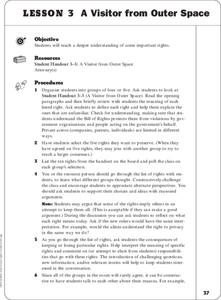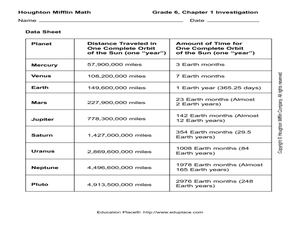Alabama Learning Exchange
The Big Bang Theory: An Evidence-Based Argument
What evidence supports the big bang theory? Individuals analyze scholarly resources about the the theory and develop arguments backed by evidence. They brainstorm, share ideas, watch a video, and read articles to complete a graphic...
American Museum of Natural History
One-on-One With The Sun
Follow along as Stella Stardust interviews the sun. A fun and informative interview provides scholars with information about the sun.
Starry Night Education
The Stars
Three astronomy activities in one resource! Here you will find one hands-on activity, one demonstration, both with discussion questions, and one activity worksheet. During these lessons young scientists discuss how stars are different,...
Community Consolidated Schools District 168
Solar System Model Project
Challenge young astronomers to demonstrate their knowledge of the solar system with this fun open-ended science project. Provided with a short list of requirements, students are given the freedom to use their creativity and whatever...
Lunar and Planetary Institute
Oreo Moon Phases
Learning about the moon has never tasted delicious! Using the popular Oreo cookie as a model, young scientists carve out the cream filling to represent the different phases of the moon.
Lunar and Planetary Institute
Moon Flip Book
Watch an entire month flash before your eyes with this fun phases-of-the-moon flip book activity.
Star Wars in the Classroom
Star Wars Geography Unit
What kind of animals live on an ice planet like Hoth? How would the habitat on Tatooine allow different organisms to thrive? Connect social studies, science, and Star Wars in one engaging activity that focuses on the ecosystems of the...
Columbus City Schools
Moon Phase Mania
Now you see it, now you don't. Our moon seems to pull a disappearing act from time to time—but why? Take your seventh grade scientists above and beyond to discover the truth about the moon and the role it plays in Earth's little corner...
Las Cumbres Observatory
Calculating the Age of Solar System Objects
The number of craters on the surface of solar system objects has a direct correlation to its age. Learners use the concept to determine the age of several objects in the solar system. Using satellite images, they count craters within a...
Curated OER
Pan's Highway-Saturn's Rings
In this Pan's highway worksheet, students read about the Cassini spacecraft that discovered how Pan clears out the ring debris in the outer A-ring system of Saturn. Students use an image taken by the satellite to find the scale of the...
Curated OER
A Galaxy Up Close
In this Sombrero Galaxy worksheet, students observe infrared images taken by the Spitzer Infrared Telescope and the Hubble Space Telescope. They answer 9 questions about the details of the images such as the radius of the stellar...
Curated OER
How is the Periodic Table Arranged?
In this periodic table worksheet, students fill in a portion of the periodic table with the atomic number of the element, the electron configuration of the element, the number of shells and the number of outer shell electrons. They...
Curated OER
What are the Trends in the Periodic Table?
In this periodic trends worksheet, students fill out a portion of a periodic table with the atomic number, the atomic radius, the number of shells and the number of outer shell electrons for each element shown. They answer six questions...
Curated OER
Spitzer Explores a Dying Star
In this dying star activity, students read about the Spitzer Space Telescope that detected the dying star-Messier-57. Students solve 6 problems including determining the total power produced by the dying star, they find the total mass of...
Curated OER
Out of This World Writing!
Miss Frizzle's class provides the inspiration for your young learners! Read "The Magic School Bus Explores Outer Space," and discuss the solar system. First learners will complete a KWL chart about a planet they're assigned to. Then, as...
Curated OER
Lesson 3: A Visitor From Outer Space
Students review provisions of Bill of Rights and First Amendment, choose five rights they would like to preserve, support their choices and ideas with reasoned arguments, and discuss consequences of keeping or losing particular rights.
Curated OER
Outer Space and Beyond
Young scholars compare and contrast the size, characteristics, composition, and orbits of the planets in our Solar System. They view a PowerPoint presentation, and in small groups conduct Internet research on a selected planet. Each...
Curated OER
once and future MOON
Beyond the phases of the moon, this comprehensive lesson plan covers geologic history and geology. Amateur astronauts examine photos of the lunar landscape, experiment with the creation of craters, and delve into information about the...
Curated OER
The Sun, Moon, and Our Solar System: Teacher/Student Notes
Introduce basic Earth and space science to your budding astronauts. This handout works in two ways, the first part provides information about the sun, moon, eclipses, and Earth to be read to or by the class. The second part is composed...
Curated OER
Move Your Muscles!
Students, through teacher lecture and class discussion, explore the three different types of muscles in the human body and the effects of microgravity on these muscles. They explain what happens to muscles in outer space and describe the...
Curated OER
Our Amazing Skeleton
Pupils study the skeleton, about the number of and types of bones in the body, and how outer space affects astronauts' bones. They discover how to take care of their bones here on Earth to prevent osteoporosis, or, weakening of the...
Curated OER
My Alien
Students listen to text read from "Hello! Anybody Out There?" and then brainstorm what aliens from outer space look like and do they exist at all.
They then will describe the physical features and a special ability or quality of an alien.
Curated OER
Grade 6 Math Investigation
In this math investigation worksheet, students find five facts about outer space that contain a number greater then ten million, underlining the digit in the ten millions place. Worksheet has a chart with facts beyond the 10 million place.
TLS Books
Jupiter
Young astronomers read an informational text on the gas giant, Jupiter. Then they answer four multiple choice questions based on what they read.
Other popular searches
- Outer Space Preschool
- Planets Outer Space
- Outer Space Art
- Living in Outer Space
- Math and Outer Space
- Outer Space Kwl Chart
- Outer Space Travel
- Outer Space Art Lesson
- Art and Outer Space
- Music About Outer Space
- Outer Space Hotel
- Outer Space Kl Chart

























